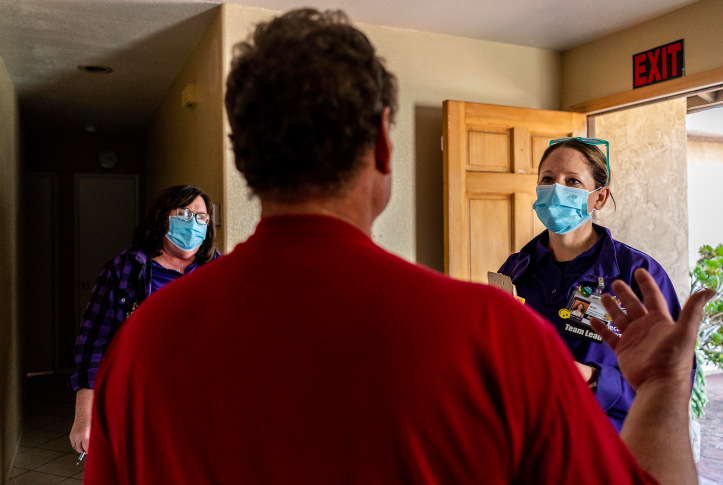In the 2022 State of the Union address and budget request for 2023, President Biden proposed a series of initiatives to address the mental health crisis in the United States. The Biden proposals, which dovetail with several bipartisan Congressional priorities, focus on the following priority areas:
- addressing mental health needs among children and young adults
- ensuring the behavioral health workforce can provide timely access to equitable, appropriate care
- reducing rates of suicide and the criminalization of people with mental conditions
- expanding access to mental health services in health care and community settings.
While bipartisan behavioral health reforms make their way through Congress, there are four key policy areas where the administration can take immediate action under existing authority. These recommendations are a subset of the actions we identified in “Meeting the Moment: Policies to Improve Behavioral Health Care in the U.S.,” a set of policy papers produced by the USC–Brookings Schaeffer Initiative for Health Policy.
Hold Public Insurance Plans Accountable for Providing Access Across Treatment Settings
Despite progress, the mental health system still fails many people. Half of those with diagnosable conditions go untreated, and the number of patients receiving care from evidence-based models has declined in the past several years. One reason is that insurers and providers are not held accountable for the care they provide. To help remedy this situation, the Centers for Medicare and Medicaid Services (CMS) has an opportunity to work with the Health Resources and Services Administration to develop additional network adequacy measures. These would go further than current and recently proposed measures of network adequacy, assessing the quality and continuity of care people receive, as well as whether they are able to access specific behavioral health services. In addition, CMS can expand performance measures for behavioral health care in public programs, including Medicare Advantage, the Medicare Shared Savings Program, and Medicaid Managed Care. These measures should focus on the integration of behavioral health into primary care as well as telehealth. CMS and states also should continue to address the digital divide to ensure that telehealth equitably reaches all groups of people.
Fully Leverage Medicaid’s Early and Periodic Screening, Diagnostic, and Treatment Program
The Bipartisan Safer Communities Act requires the U.S. Department of Health and Human Services (HHS) to review how states provide Medicaid services for children under the Early and Periodic Screening, Diagnostic, and Treatment (EPSDT) program. This creates a long-overdue opportunity for CMS to assess behavioral health service provision for children and youth and work with states to substantially strengthen behavioral health service provision through EPSDT. HHS can maximize this opportunity by exploring the following areas in state EPSDT reviews:
- The extent to which children are consistently screened for mental health conditions and are connected to services when identified.
- Strategies states use to improve children’s access to prevention and early intervention services (e.g., age-appropriate diagnostic criteria; removing requirements that beneficiaries be diagnosed with a mental health condition before receiving services).
- The extent to which states are providing community-based services for children with mental illness when appropriate, including intensive care coordination, family and youth peer-support services, and in-home services and supports.
- How states and managed care organizations coordinate mental health prevention and treatment services across settings — including schools, primary care settings, specialty services, and home- and community-based services — to ensure access to follow-up and treatment.
Expand Coverage of Crisis Services Across Payers
Although Congress and the administration have taken steps to improve behavioral health crisis care, it remains challenging to finance the full continuum of crisis services, especially because of limited coverage by Medicare and private insurance. There is a range of strategies HHS can employ to make financial resources more available for crisis care and increase the likelihood of services being offered across payers.
CMS can:
- Allow ongoing stabilization services and mobile crisis team services provided in emergency departments to qualify for the enhanced match for mobile crisis in the American Rescue Plan Act.
- Encourage states to use Children’s Health Insurance Program health service initiatives to fund crisis-related activities for children.
- Align new Medicare mobile crisis activities with Medicaid.
HHS can encourage states and commercial plans to:
- Include crisis services in the definition of essential health benefits.
- Expand the availability of payment for stabilization units through tri-department (i.e., Labor, HHS, and Treasury) regulations for coverage of emergency services.
- Leverage Mental Health Parity and Addiction Equity Act regulations to expand access to emergency services.
Build the Evidence Base of Preventive Mental Health Care Services in Nontraditional Settings
There is growing interest in expanding access to mental health care outside of traditional health care settings. HHS could help build the evidence base by deploying its research arms to assess the outcomes of these approaches. It could tie the results of its research to grantmaking. This could be modeled on the approach HHS uses to make grants for home visiting programs, in which HHS conducts evidence reviews and drives state grant funding to prioritize effective interventions.
Conclusion
The administration and Congress have taken steps to address mental health challenges, but more effort is needed. The policy changes outlined here would have a significant impact on mental health and could be pursued under existing authority. If implemented, they can serve as a down payment on future progress.







